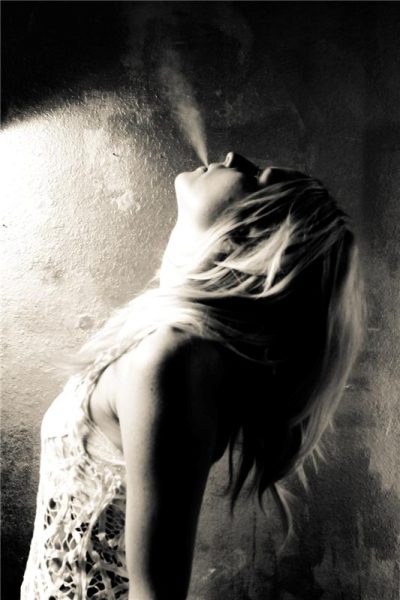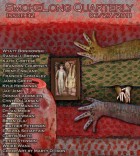Kyle, I hope you don’t mind me saying, but “All My Friends” makes me think of M C Escher, in particular his Relativity lithograph, which, like your story, contains multiple perspectives linked by a common theme. I am curious to know if art enters into your creative process, and if so, how?
First, let me say my writing has always been more inspired by music, but lately I’ve come under the influence of such visual artists as Raymond Pettibon and Richard Prince, both who make artistic statements about modern culture or in the case of Prince (who did the Sonic Youth jacket design of Sonic Nurse), actually does some kind of distortion of it as in his re-photographing of photos. But yes, as in art, I like taking a theme and doing some kind of distortion of it, as in this case of the bond among friends. But here the bond is tenuous, full of unreality, addictions, and in the end, both the narrator’s and the friends’ identities are called into question.
Also, I think art can be interpreted as “art” in a more general sense that includes music, dance, etc. And getting back to music, the line (almost a chorus, if you will) about “all my friends…” came to me while I was thinking about an old MacKendree Springs song from the ’70s. I believe the song was about drug abuse. It seems the characters in this piece need some kind of addiction to cope. And there seems, to me at least, there’s always that crack that one may fall into and never return.
I love the opening line, “All my friends are junkies,” but I don’t know who to pity more, the narrator or the friends. Tell me about those around you, those among your everydayness, who in one way or another inspired the characters in the story.
If the characters in my stories are based on anyone real, they are usually based on people I’ve known in the past. As of now in my old age, I don’t get around that much — it’s pretty much work and home, very little socializing. These characters were based on the fly-by-night characters I met in the NYC clubs in the late ’80s and early ’90s, where bonds are formed as easily as they are broken by a morning shaft of light. And in that hazy unreality of the club scene, you’re really never sure who you are talking to, and they might feel the same. There is that kind of unreality about it.
Dr. Phil, Oprah, the Life Channel, Reality TV, all “celluloid like me.” The disintegration between that which is real and that which is quasi-real dominates “All My Friends.” I am curious to know your own relationship with television.
Well there is that love/hate relationship, the ability to turn on and turn off, the flick of the remote and you are transported somewhere else, or to a life you wished you had. I have to admit that I think there is so much junk on TV, and often I prefer the Internet. But then again, I think of those old shows that helped shape — not just me — but others. Look at all those images of heroes we grew up with, or the women who girls modeled themselves on. It’s a crazy relationship. You idolize someone or want to be someone who is not real. You can see them, but they cannot see you. It’s not reciprocal. And you’re pretending they’re real. I believe David Foster Wallace made a point of this in at least one of his essays — how the media shapes our version of who we are. There’s a kind of insanity about it. We’re always looking for some kind of role model as to how to think and feel and behave. And we always fall short, don’t we? Then comes the realization that the person on TV doesn’t even know we exist.
You have a collection of prose as well as poetry, the exact number of each I don’t recall. Tell us about them. Maybe give us a title or two of your favorite pieces. I’d also love to hear how in Kyle Hemming’s world, poetry and short fiction interact with each other, suffuse each other, perhaps even quarrel with each other.
Actually I have two collections of hybrid forms: both prose and poetry. Avenue C and Cat People, both from Scars Publications. How does the poetry and prose interact? I think in many of the pieces there’s a music in them or they were inspired by music. I think of music as one kind of meaning. Sometimes I’ll choose a word not only for its denotation/connotation, but for its sound, which might help to create a tone, a color. I might add that I love the prose poem. The quarrel for me comes when music becomes overwhelming and the story/flash loses its focus. It then becomes an issue of where am I going with this.
Your style is unique, fresh, what some might call experimental or non-traditional. In my mind, this takes courage, vision, perhaps an oblique perspective on the world in general. What type of things (objects, events, people, other writers, etc) inspire you to create such distinct work? How do you see your own work in comparison to “traditional” prose (or poetry for that matter)?
The inspiration comes from various sources. As already mentioned, music is important to me. It filled many empty moments of my life. Another is the idea of time. Lately, I’ve been playing around with it, how the past influences the present, how we see the past depending upon which “present” we are in, how distance changes or blurs the past, and we must reinvent what we can’t remember exactly. That, lately, has inspired me to write. And there is also the idea that the next story/poem will be The Breakthrough. The homerun hitter. And of course, none of us are complete. We compensate by visiting imaginary place or becoming imaginary people.
In answer to the second question, I see my work as being all over the place, in contrast to some writers, like Faulkner, whose stories had a very consistent sense of time and place and style. I mean, I’ve written both literary and genre, and concerning the latter, I find that Horror comes easier to me than Fantasy or Sci-fi. I’ve done Humor, Sci-fi, Bizzaro, but mostly Literary. What became important to me at a certain point was the search for a defining context, in terms of setting and character. In Avenue C, it was NYC in the late eighties and the romantic but self-destructive character dancing under strobe lights. In Cat People, it turned into something of a Sci-fi like context: otherwise ordinary people with cat-like qualities against a Manga/cartoon like background.
Interviews always seem to leave out one thing or another. Tell us something about Kyle Hemmings, his work, his world, his passion, his likes or dislikes, about which I failed to ask. Give us a peek on the inside. Tell us your favorite pizza topping or ice cream flavor or musician or what your solutions are to global chaos and human disintegration.
Lately, I’ve been following the lives of ex-rockers from the ’60s and ’70s. People like the late Arthur Lee, Randy Holden, Danny Kalb, John Cipollina, and Roky Erickson. I could write a book about them. So much triumph and tragedy. Glad to see that Kalb in his late sixties is still playing acoustic blues in a three-piece band. And I have an obsession with album covers. I think that some of the most underrated art passed us by in the form of ’60s/’70s album covers. I think the album cover of Buffalo Springfield’s final record —Last Time Around — was a masterpiece.
As for the other stuff, I like my pizza plain, and any flavor ice cream except chocolate is fine with me. My solution to global chaos: everybody start taking dance lessons, ride a bicycle for at least an hour a day, and read my chapbook — Cat People.



 The core workshop of SmokeLong Fitness is all in writing, so you can take part from anywhere at anytime. We are excited about creating a supportive, consistent and structured environment for flash writers to work on their craft in a community. We are thrilled and proud to say that our workshop participants have won, placed, or been listed in every major flash competition. Community works.
The core workshop of SmokeLong Fitness is all in writing, so you can take part from anywhere at anytime. We are excited about creating a supportive, consistent and structured environment for flash writers to work on their craft in a community. We are thrilled and proud to say that our workshop participants have won, placed, or been listed in every major flash competition. Community works.